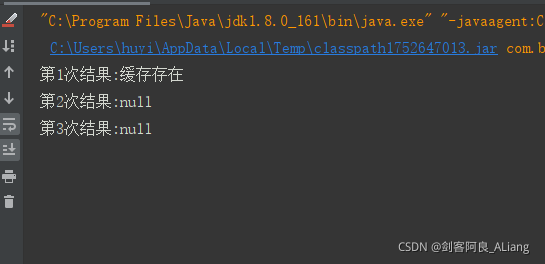这篇文章主要为大家展示了“Java中TimedCache带时间缓存工具类怎么用”,内容简而易懂,条理清晰,希望能够帮助大家解决疑惑,下面让小编带领大家一起研究并学习一下“Java中TimedCache带时间缓存工具类怎么用”这篇文章吧。
简述
我们在工作中会碰到需要使用带过期时间的缓存场景。但是使用redis有太重了,毕竟缓存的数据很小,放在内存够够的。hutools提供了TimedCache时间缓存工具,可以实现该场景。下面使用到该组件,并为了适配工作场景,对该工具类做优化升级。
Maven依赖
<dependency> <groupId>cn.hutool</groupId> <artifactId>hutool-all</artifactId> <version>5.4.6</version> </dependency> <dependency> <groupId>com.google.guava</groupId> <artifactId>guava</artifactId> <version>30.1.1-jre</version> </dependency>简单使用
不多说了,上代码。
import cn.hutool.cache.CacheUtil;import cn.hutool.cache.impl.TimedCache;import cn.hutool.core.thread.ThreadUtil; public class TimedCacheUtils { private static final TimedCache<String, String> TIMED_CACHE = CacheUtil.newTimedCache(5000); static { TIMED_CACHE.schedulePrune(5); } public static void put(String key, String value, Long timeout) { TIMED_CACHE.put(key, value, timeout); } public static String get(String key) { return TIMED_CACHE.get(key); } public static void main(String[] args) { put("haha", "1", 3000L); ThreadUtil.sleep(2000); // if (TIMED_CACHE.containsKey("haha")) { // System.out.println("aa"); // } System.out.println("第1次结果:" + get("haha")); ThreadUtil.sleep(2000); System.out.println("第2次结果:" + get("haha")); ThreadUtil.sleep(5000); System.out.println("第3次结果:" + get("haha")); // 取消定时清理 TIMED_CACHE.cancelPruneSchedule(); }}首先我们看一下执行的效果

说明:
设置的超时时间为3000毫秒,所以第一次打印在2秒钟,所以可以获取到值。
因为第一次打印调用了get方法,刷新了过期时间,所以依然可以获取到值。
第三次打印在5秒后,所以已经过期,无法获取到值,打印null。
那么,需要知道是否缓存还在可以使用containsKey方法。如下:
put("haha", "1", 3000L); ThreadUtil.sleep(2000); if (TIMED_CACHE.containsKey("haha")) { System.out.println("第1次结果:缓存存在"); }// System.out.println("第1次结果:" + get("haha")); ThreadUtil.sleep(2000); System.out.println("第2次结果:" + get("haha")); ThreadUtil.sleep(5000); System.out.println("第3次结果:" + get("haha")); // 取消定时清理 TIMED_CACHE.cancelPruneSchedule();执行结果如下:

工具优化-监听过期、增加回调
我们在使用TimedCache会发现,一旦缓存过期我们并不能立马知道,很多工作场景中需要对缓存做监听回调。所以我升级了一下该工具类。
import cn.hutool.cache.CacheUtil;import cn.hutool.cache.impl.TimedCache;import cn.hutool.core.thread.ThreadUtil;import com.google.common.util.concurrent.*;import org.checkerframework.checker.nullness.qual.Nullable; import java.text.MessageFormat;import java.util.concurrent.ConcurrentHashMap;import java.util.concurrent.ExecutorService;import java.util.concurrent.Executors;import java.util.function.Consumer; public class TimedCacheUtils { private static final TimedCache<String, String> TIMED_CACHE = CacheUtil.newTimedCache(5000); private static final ExecutorService executorService = Executors.newCachedThreadPool(); private static final ListeningExecutorService listeningExecutorService = MoreExecutors.listeningDecorator(executorService); private static ConcurrentHashMap<String, Consumer<String>> callbackMap; public static void put(String key, String value, Long timeout, Consumer<String> consumer) { TIMED_CACHE.put(key, value, timeout); addListen(key, consumer); } public static String get(String key) { return TIMED_CACHE.get(key); } public static void remove(String key) { callbackMap.remove(key); TIMED_CACHE.remove(key); } public static void addListen(String key, Consumer<String> consumer) { ListenableFuture<String> listenableFuture = listeningExecutorService.submit( () -> { while (TIMED_CACHE.containsKey(key)) { ThreadUtil.sleep(500); } return key; }); Futures.addCallback( listenableFuture, new FutureCallback<String>() { @Override public void onSuccess(@Nullable String s) { consumer.accept(s); } @Override public void onFailure(Throwable throwable) { throwable.printStackTrace(); } }, listeningExecutorService); } public static void main(String[] args) { put("haha", "1", 3000L, x -> System.out.println(MessageFormat.format("[{0}] - 缓存消逝", x))); ThreadUtil.sleep(2000); System.out.println(get("haha")); ThreadUtil.sleep(2000); System.out.println(get("haha")); ThreadUtil.sleep(5000); System.out.println(get("haha")); // 关闭监听线程池 listeningExecutorService.shutdown(); }}以上是“Java中TimedCache带时间缓存工具类怎么用”这篇文章的所有内容,感谢各位的阅读!相信大家都有了一定的了解,希望分享的内容对大家有所帮助,如果还想学习更多知识,欢迎关注编程网行业资讯频道!




